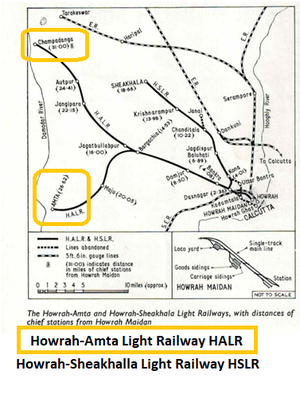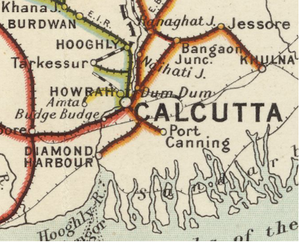Howrah-Amta Light Railway: Difference between revisions
1909 Railway Map Section added |
Map and info from Raiway Magazine added |
||
| Line 30: | Line 30: | ||
|system3details= | |system3details= | ||
}} | }} | ||
The '''Howrah-Amta Light Railway''' (HALR) was a short 2ft/610mm narrow gauge([[Rail_gauge#Narrow_Gauge|NG]]) railway which ran from [[Howrah]] westwards to [[Amta]]. | The '''Howrah-Amta Light Railway''' (HALR) was a short 2ft/610mm narrow gauge([[Rail_gauge#Narrow_Gauge|NG]]) railway which ran from [[Howrah]] westwards to [[Amta]]. | ||
<ref name=Admin>[https://archive.org/stream/BombayBarodaAndCentralIndiaRailwaySystem/Bombay_Baroda_And_Central_India_Railway_System#page/n251/mode/2up "Administration Report on the Railways in India – corrected up to 31st March 1918"; Superintendent of Government Printing, Calcutta; page 243]; Retrieved 31 Aug 2016</ref> | <ref name=Admin>[https://archive.org/stream/BombayBarodaAndCentralIndiaRailwaySystem/Bombay_Baroda_And_Central_India_Railway_System#page/n251/mode/2up "Administration Report on the Railways in India – corrected up to 31st March 1918"; Superintendent of Government Printing, Calcutta; page 243]; Retrieved 31 Aug 2016</ref> | ||
[[File:Howrah-Amta Light Railway.png|thumb|'''Howrah-Amta Light Railway''']] | |||
[[File: Howrah-Amta Light Railway Map 1909.png|thumb| Howrah-Amta Light Railway Map 1909]] | |||
The HALR was one of several small narrow gauge concerns owned and worked by [[Martin's Light Railways]], a management company based in [[Calcutta]]. | The HALR was one of several small narrow gauge concerns owned and worked by [[Martin's Light Railways]], a management company based in [[Calcutta]]. | ||
<ref name=Wiki>[http://en.wikipedia.org/wiki/Martin%27s_Light_Railways Wikipedia"Martin's Light Railways"]; Retrieved 31 Aug 2016</ref> | <ref name=Wiki>[http://en.wikipedia.org/wiki/Martin%27s_Light_Railways Wikipedia"Martin's Light Railways"]; Retrieved 31 Aug 2016</ref> | ||
| Line 45: | Line 45: | ||
The Howrah-Amta line was opened up to Domjur in 1897, and to [[Amta]] in 1898. An extension from Bargachhia (Bargechhe) junction to Antpur was opened in 1904, and a further extension to Champadanga in 1908, giving a total line length of 44 miles (70km) <ref name=Admin/>. | The Howrah-Amta line was opened up to Domjur in 1897, and to [[Amta]] in 1898. An extension from Bargachhia (Bargechhe) junction to Antpur was opened in 1904, and a further extension to Champadanga in 1908, giving a total line length of 44 miles (70km) <ref name=Admin/>. | ||
The Howrah- Amta Light and the [[Howrah-Sheakhalla Light Railway|Howrah-Sheakhalla Light]] Railways start from | The Howrah- Amta Light and the [[Howrah-Sheakhalla Light Railway|Howrah-Sheakhalla Light]] Railways start from Telkal Ghat on the Hooghly river, and skirting the Howrah Maidan pass through the crowded Panchanantala road to Kadamtala station. Here they separate, the Howrah-Sliiakhala line running north-west along the Benares road to the border of the district, and thence to Shiakhala in Hooghly district. The Howrah-Amta line runs west, chiefly along the side of the Jagatballabhpur road, and then goes south-west to Amta <ref name=Wiki/>. | ||
A line from Autpur to Rajbalhat was sanctioned but never built <ref name=Maiden>”Two foot gauge at Howrah Maiden” by P J Bowcutt and H C Hughes. ‘Railway Magazine’ September 1965 Vol III No 773 pages 497-501</ref> | |||
The Amta and Sheakhala companies both prospered and by 1904 the shareholders were already getting dividends of 7 and 5 per cent respectively. By 1914 over 2,500,000 passengers were being carried annually on the two lines, and by 1928 the number was nearly 4,000,000. Working frequent trains through the streets of Howrah, each preceded by a runner with a bell to warn pedestrians, became a major headache and from September 26, 1939, after the Municipality had refused to renew the existing agreement, Kadamtala became the terminus and the line to Howrah Ghat was abandoned <ref name=Maiden/>. | |||
The lines continued to operate privately long after Independence in 1947, and finally converted to Broad Gauge and electrified from 1984 onwards <ref name=Wiki/>. | The lines continued to operate privately long after Independence in 1947, and finally converted to Broad Gauge and electrified from 1984 onwards <ref name=Wiki/>. | ||
Revision as of 15:35, 19 November 2018
| Howrah-Amta Light Railway | ||
|---|---|---|
| [[Image:|150px| ]] | ||
| Line of route | ||
| Howrah to Amta | ||
| Gauge / mileage | ||
| 2' 0" NG | 37 miles (1905) 42 miles (1943) | |
| Timeline | ||
| 1898 | Line opened to traffic | |
| 1971 | Closed | |
| Key locations | ||
| Presidency | Bengal | |
| Stations | Howrah, Amta | |
| System agency | ||
| Worked by Martin's Light Railways | ||
| How to interpret this infobox | ||
The Howrah-Amta Light Railway (HALR) was a short 2ft/610mm narrow gauge(NG) railway which ran from Howrah westwards to Amta. [1]


The HALR was one of several small narrow gauge concerns owned and worked by Martin's Light Railways, a management company based in Calcutta. [2]
History
On 12 June 1889 an agreement was signed between the District Board of Howrah and Messrs. Walsh, Lovett & Company on behalf of the Bengal District Road Tramways Company; this gave the Company the right to construct and work a tramway over a portion of roads [1]. This was subsequently renewed with Martin's Light Railways Co Ltd and sanctioned by Government notification in the Calcutta Gazette of 27 March 1895 [2]. On the 2 May 1895 the 'Howrah-Amta Light Railway Company’ was formed and worked by Martin's Light Railways (MLR).
The Howrah-Amta line was opened up to Domjur in 1897, and to Amta in 1898. An extension from Bargachhia (Bargechhe) junction to Antpur was opened in 1904, and a further extension to Champadanga in 1908, giving a total line length of 44 miles (70km) [1].
The Howrah- Amta Light and the Howrah-Sheakhalla Light Railways start from Telkal Ghat on the Hooghly river, and skirting the Howrah Maidan pass through the crowded Panchanantala road to Kadamtala station. Here they separate, the Howrah-Sliiakhala line running north-west along the Benares road to the border of the district, and thence to Shiakhala in Hooghly district. The Howrah-Amta line runs west, chiefly along the side of the Jagatballabhpur road, and then goes south-west to Amta [2].
A line from Autpur to Rajbalhat was sanctioned but never built [3]
The Amta and Sheakhala companies both prospered and by 1904 the shareholders were already getting dividends of 7 and 5 per cent respectively. By 1914 over 2,500,000 passengers were being carried annually on the two lines, and by 1928 the number was nearly 4,000,000. Working frequent trains through the streets of Howrah, each preceded by a runner with a bell to warn pedestrians, became a major headache and from September 26, 1939, after the Municipality had refused to renew the existing agreement, Kadamtala became the terminus and the line to Howrah Ghat was abandoned [3].
The lines continued to operate privately long after Independence in 1947, and finally converted to Broad Gauge and electrified from 1984 onwards [2].
References
- ↑ 1.0 1.1 1.2 "Administration Report on the Railways in India – corrected up to 31st March 1918"; Superintendent of Government Printing, Calcutta; page 243; Retrieved 31 Aug 2016
- ↑ 2.0 2.1 2.2 2.3 Wikipedia"Martin's Light Railways"; Retrieved 31 Aug 2016
- ↑ 3.0 3.1 ”Two foot gauge at Howrah Maiden” by P J Bowcutt and H C Hughes. ‘Railway Magazine’ September 1965 Vol III No 773 pages 497-501